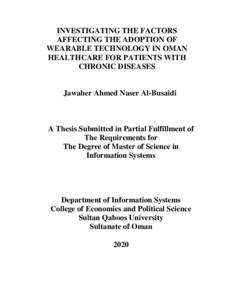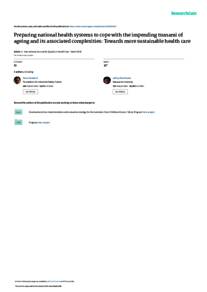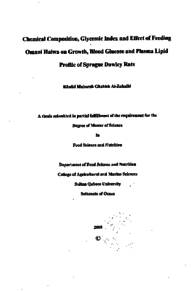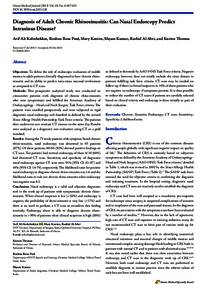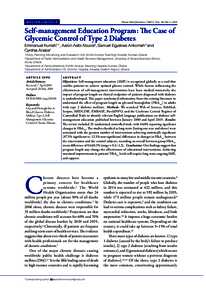Document
Investigating the factors affecting the adoption of wearable technology in Oman healthcare for patients with chronic diseases.
Publisher
Sultan Qaboos University.
Gregorian
2020
Language
English
English abstract
Medical wearable devices as a revolutionary technology gained more attraction by
most dominant organizations like Apple and Google. Advanced wearable devices are
used along with Artificial intelligence for the cardiology and other purposes. Thus,
Machine learning helped to test the patient's vital signs like heart rate.
This study aims to examine different factors that influence the adoption of wearable
technologies in Oman healthcare for patients with chronic diseases. Also, to propose a
model based on integrated theories (UTAUT2 and Protection Motivation Theory) to
investigate how patients can adopt wearable technology in the healthcare sector. A
quantitative methodology is followed using a survey distributed to around 350 patients
to assess each factor proposed by the model. Data collected has been analysed using
SPSS package AMOS.
Structural Equation Modelling (SEM) was employed to test the proposed hypotheses.
The results showed Performance Expectancy (PE), Hedonic Motivation (HM),
Perceived Irreplaceability (PIR), Perceived Privacy Risk (PPR), and Regulatory
Expectations (RE) have a significant influence on the patient's acceptance of using
wearable technologies. This study is the first research which is empirically
investigating the acceptance of healthcare wearable technology focusing on Omani
patients. Wearables enable technical and healthcare decision-makers to form better
decisions in order to implement wearable technologies in the most efficient and useful way.
Member of
Resource URL
Arabic abstract
نجحت الأجهزة الطبية القابلة للارتداء، باعتبارها تكنولوجيا ثورية، في جذب المزيد من اهتمام معظم المؤسسات الكبرى مثل "ابل" و "جوجل" ويجري استخدام هذه الأجهزة المتقدمة مقرونة بالذكاء الأصطناعي ألغراض كثيرة مثل أمراض القلب. ولذا ساعد التعلم الألي في فحص الكثير من المؤشرات الحيوية مثل معدل ضربات القلب. تهدف هذه الدراسة إلى دراسة العوامل التي تؤثر على استخدام التكنولوجيا القابلة للارتداء في قطاع الرعاية الصحية في عمان للمصابين بالأمراض المزمنة، إضافة الى طرح نموذج يستند إلى نظريات متكاملة )النظرية الموحدة لقبول واستخدام التكنولوجيا )UTAUT2 )ونظرية دافع الحماية ) Motivation Protection Theory ،)لمعرفة كيف يمكن للمرضى استخدام تكنولوجيا قابلة لإلرتداء في قطاع الرعاية الصحية. ويجري اتباع منهجية كمية باستخدام استبيان موزع على 334 مريض لتقييم كل عامل يطرحه النموذج. كما تم تحليل البيانات المجمعة باستخدام حزمة )SPSS )و )AMOS.) جرى استخدام نموذجة المعادالت الهيكلية الختبار الفرضيات المطروحة، وأظهرت النتائج وجود أثر كبير لتوقع الأداء والدوافع الشعورية وادراك انعدام البدائل ومخاطر الخصوصية المدركة والتوقعات التنظيمية على قبول المريض لاستخدام التكنولوجيا القابلة للارتداء. وتعد هذه الدراسة أول بحث يدرس مدى تقبل تكنولوجيا الرعاية مّك لرعاية الصحية القابلة للارتداء تجريبيا بالتركيز على المرضى العمانيين. إذ انه ي ن متخذي القرار في مجال ا الصحية والتكنولوجيا من اتخاذ قرارات أفضل لتطبيق التكنولوجيا القابلة لإلرتداء بأكثر الطرق فاعلية وفائدة. الكلمات الداللية: التكنولوجيا القابلة للارتداء ، الرعاية الصحية، الأمراض المزمنة، النظرية الموحدة لقبول واستخدام التكنولوجيا )UTAUT2.)
Category
Theses and Dissertations

